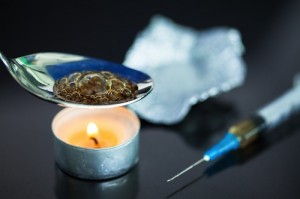The United States Department of Labor describes heroin as a white, odorless, crystalline powder that tastes bitter when it hits the tongue. By this description, heroin seems remarkably benign, as if it’s a powder that might be spilled on a counter-top and then quickly wiped away by the cleaning staff.
In reality, this is one of the most powerful drugs available in the illicit marketplace, capable of causing very persistent cases of addiction with breathtaking speed.
A Remarkable Chemical
Street Terms for Heroin
During heroin’s long history of use, the drug has acquired a plethora of street names and pseudonyms. According to the National Institute on Drug Abuse (NIDA), the most common terms for heroin on the street include “ska,” “junk” and “smack.” Additional street names for heroin include “dope,” “horse” and simply “H.” Heroin slang terms also sometimes refer to the euphoric effects of the drug, with nicknames like “Dr. Feelgood,” while other slang terms for heroin include the appearance of the drug itself, such as “brown,” “brown sugar,” “China white,” “mud,” “black tar” and “Mr. Brownstone.”
According to PBS, heroin was first synthesized in 1895, when an employee of the Bayer Company tinkered with morphine in the laboratory. This miracle drug was once considered a perfect medication that could help morphine addicts to heal, but in time, people found that heroin was just as addictive as morphine, and as a result, heroin was effectively banned in the United States by the middle of the 1920s.
At this point, there are no legitimate medical uses for heroin, so it can’t be legally obtained in this country. Instead, the drug is used exclusively for recreational purposes. Users might refer to the drug as “smack,” “junk,” “skag,” “China white” or “horse,” but no matter what name they use, it’s likely they’ll find the drug easy to buy from street dealers. With a few dollars, they might buy a dose of drugs that can deliver a boost of pleasure and a deep sense of relaxation. In a few hours, they might awaken feeling fine, but deep inside, chemical changes are taking place that tend to lock an addiction in place.
Sensations associated with heroin come about due to chemical reactions. Huge amounts of dopamine are released by the cells of the brain, and in time, the receptor cells for this chemical seem to burn out. They no longer respond so dramatically, and they may even refuse to work at all, unless heroin is present. Dysfunctional cells like this can cause intense discomfort during the withdrawal process, and sometimes, the cells can even emit signals of distress between doses of heroin.
People under the spell of drugs in this manner are simply incapable of modulating their use, as they feel physically ill without heroin. The National Institute on Drug Abuse suggests that 23 percent of heroin users eventually demonstrate symptoms of dependency just like this, and while they might believe that they’re keeping their troubles under wraps, they may demonstrate symptoms that their families might quickly spot.
Warning Signs
 Heroin can be snorted or smoked, but many users choose to inject the substance, and often, they use dirty needles and other forms of unclean equipment in order to do that work. As a result, people might develop:
Heroin can be snorted or smoked, but many users choose to inject the substance, and often, they use dirty needles and other forms of unclean equipment in order to do that work. As a result, people might develop:
- Puncture marks moving up and down their arms
- Infections or sores in older puncture marks
- Closed or blocked veins that cause localized swelling
- Blackened or bluish fingertips, due to blocked blood
Heroin users might also seem intensely sedated on a regular basis, nodding off in the middle of conversations and floating away while watching television. During these episodes, people might be difficult to awaken, and they may have pupils that seem much too small.
Physical signs of heroin use include chronic itching; dry skin that can be cracked, bleeding or ashen in appearance; and track marks from repeated scarring due to needle injections (known as “track marks”). Other physical indications of heroin addiction can include pinpoint pupils, altered sex drive, respiratory problems, fevers, chills and sheer exhaustion. Digestive problems are another hallmark of heroin addiction, with frequent episodes of constipation and nausea. Heroin can also cause a disappearance of appetite, with one of the classic signs of heroin use being severe and rapid weight loss – a phenomenon that inspired the term “heroin chic” in the description of underweight runway models. See More: Long-Term Health Effects
Psychological symptoms of heroin addiction can include hallucinations, depression and paranoia. Breaks with reality, memory problems and slowed cognition also have been associated with heroin addiction. Though rare, heroin can also trigger symptoms of psychological disorders, such as schizophrenia, to emerge.
Behavioral changes are common in heroin addicts. Because heroin can lead to lowered appetite and metabolism, heroin addicted individuals are generally lethargic and fatigued – an effect enhanced by the drug’s sedative properties. Additionally, heroin can cause severe mood swings, leading users to burst into fits of rage, fear and despondency at a moment’s notice.
Another suggestion of heroin addiction is generally found in objects used to facilitate heroin abuse, often gathered together to form a heroin “kit.” According to the University of Maryland Center for Substance Abuse Research (CESAR), common heroin drug paraphernalia surrounding use itself includes nasal spray bottles, hypodermic needles, and a makeshift “tie-off” used to make veins raised for injection. Commonly, heroin preparatory paraphernalia also provides telltale signs of drug abuse, such as metal spoons or bottle caps (used to liquefy heroin in a process known as “cooking”), or tiny balls of cotton used to strain the drug.Glass pipes are often the most favored method of smoking heroin, though straws can also be used to ingest freebased heroin as it turns into gas over heated tinfoil in a practice known as “chasing the dragon.” Straws are also commonly used to snort heroin, as is rolled paper money. In some cases, balloons may also be indicative of heroin usage, as they are often swallowed or inserted into the body in order to conceal heroin during drug trafficking operations.
Finding Help
Withdrawal Symptoms
Insomnia, tremors, persistent nausea, severe vomiting, profuse perspiration and dangerously high fevers.
Notable Signs:
- Frequently experience goosebumps and chills: “cold turkey”.
- Involuntary muscle action of the extremities: “kicking the habit”.
- Itching where users may scratch to the point of bleeding: “itchy blood”.
- Chronic diarrhea sets in as the body adjusts to the absence of heroin.
Hallucinations, intense cravings, jolting mood alterations, suicidal tendencies, severe clinical depression and violent episodes.
The Need for Professional Detox
The combined force and intensity of these withdrawal symptoms often results in heroin addicts returning to drug use, unless treated in a professional detoxification facility.
It’s easy enough to believe that a heroin addiction is a private affair that shouldn’t impact the family in any way. Unfortunately, leaving a heroin addiction in place can be absolutely devastating to the community. For example, heroin tends to be somewhat expensive, as users often need to take very large doses in order to experience a high. Heroin can also make people so sedated that they can’t function at work. These two elements, when added together, explain the rise in crime associated with heroin use. It’s not uncommon for users to rob and steal in order to get their fix.
In addition, heroin users fuel an underworld of drug users and drug dealers who are willing to do a remarkable amount of very devastating things in order to move their products. Killing enemies, enslaving children and otherwise engaging in dastardly deeds is just part of the dealer’s lifestyle, and every heroin user is contributing to the support of that culture.
Heroin can also be deadly, particularly if users take in a large amount of the drug or a very pure type of heroin. The deaths can be swift, and the loss can leave a family devastated for months or even years. This is the true crisis, when it comes to heroin, as the death toll can be so very high.
If you or someone you love is addicted to heroin, these horrible things simply don’t have to happen to you. In fact, by getting help now, you might be able to stop the problem from spreading and growing worse. We’d like to help. Please call us to talk with our intake specialists about getting help at Axis.







